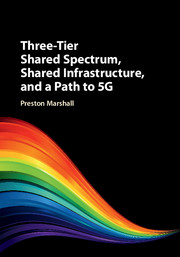Book contents
- Frontmatter
- Contents
- Acknowledgments
- Preface
- Part I Spectrum Sharing Background
- Part II Three-Tier Dynamic Spectrum Models
- Part III Components of a Three-Tier Architecture
- 5 Three-Tier Spectrum Admission Control Systems
- 6 Admission Control Management of Access Point Devices and Their Clients
- 7 Taxonomy of Protection Methods to Be Provided Across and Within Tiers
- Part IV Protection Processes for Incumbents and Peers
- Part V Example Use of Three-Tier Spectrum: Use of the 3.5 GHz CBRS Band in the USA
- Part VI Future Bands, Network Services, Business Models, and Technology
- Part VII Appendices
- Index
- References
5 - Three-Tier Spectrum Admission Control Systems
from Part III - Components of a Three-Tier Architecture
Published online by Cambridge University Press: 30 August 2017
- Frontmatter
- Contents
- Acknowledgments
- Preface
- Part I Spectrum Sharing Background
- Part II Three-Tier Dynamic Spectrum Models
- Part III Components of a Three-Tier Architecture
- 5 Three-Tier Spectrum Admission Control Systems
- 6 Admission Control Management of Access Point Devices and Their Clients
- 7 Taxonomy of Protection Methods to Be Provided Across and Within Tiers
- Part IV Protection Processes for Incumbents and Peers
- Part V Example Use of Three-Tier Spectrum: Use of the 3.5 GHz CBRS Band in the USA
- Part VI Future Bands, Network Services, Business Models, and Technology
- Part VII Appendices
- Index
- References
Summary
Database-driven Spectrum Management Framework
This chapter will develop the basic building blocks from which various forms of three-tier spectrum management systems can be constructed. The technical building blocks are based on physics and fact, and therefore are not sensitive to nations or policies. The decision-making is nation- and frequency-dependent, and therefore is addressed separately from the technical tools that provide it with the basis for its decisions. This chapter is not intended to delve into specific algorithms or protection rules in detail. These will be addressed in later chapters specific to the issues involved in each.
It is easy to view each possible spectrum management regime as having unique requirements for the database system that implements its rule structure. This chapter instead will develop a set of constructs from which various spectrum management regimes can be constructed. In this way, we can readily focus on the common elements of all systems, and lead to common components. A common model of the technical infrastructure can make the construction of new regimes more practical to implement, effective, and verifiable.
In this chapter, we will use the general term of “admission control system.” This is the general nomenclature for the functionality that is provided by the United States (US) Federal Communications Commission (FCC) Citizens Broadband Radio Service (CBRS) Spectrum Access System (SAS). Throughout this book, the term SAS will only be used for requirements that are specific to this US implementation.
Before going into other details, we can first broadly classify database systems into two classes:
Stateful Admission of nodes into the ecosystem changes the entry conditions for future entrants. The database system must be updated to reflect each admission decision or status change, and the sequencing of processing must ensure that decisions do not interact. Microwave coordination is an example of such regimes.
Stateless Admission of nodes into the ecosystem has no impact on the admission of future entrants, once the regulatory criteria is established. The system can make future decisions without regard to its own previous decisions. An example of this is determination of fixed contour based admission, such as fixed exclusion zones, or the Television White Space (TVWS) regime.
- Type
- Chapter
- Information
- Publisher: Cambridge University PressPrint publication year: 2017



